-
Posts
2,867 -
Joined
-
Last visited
Content Type
Profiles
Forums
Gallery
Events
Posts posted by AON
-
-
Hope everyone is having a great St. Patrick's Day!

I completed the installation of the hawse pieces moments ago.
Also completed the installation of the chocks at the head of the aft cant frames.
Time to start on the forward cant frames... not today though.. because my name is Uá Niáll and it's St.Patrick's Day!
-
-
Okay... I admit I have never cast anything for models. Industrially we used sand. Yes it was a special casting resin but it had no "give". It was solid.
What if you built two boxes. One as a skin for the mould. The other twice as large. Put a couple inches of sand (clean dry beach sand) on the floor of the second. Put your mould in the first box then put the first box centered in the second and on top of the bed of sand. Then pack sand all around the first but inside the second. These could be reused over and over again plus any spillage is on the sand.
Just a thought.
-
Pat
I appreciate your suggestions.
There is always the plan B that I spoke to my wife about at lunch... make the bowsprit a hair larger in diameter.
I will make a test bowsprit to see what it looks like with and without the leather layer.
I have coloured paper to simulate the leather for the test.
Thank you... I learnt something from you today.
-
More of those moments then I care to admit to!
My back is back to normal, thank you for asking. I hope you are back on your feet again.
Only people with this infliction understand how debilitating, aggravating and painful it really is.
Back to this leather capping on the head of the stem post and apron.
Would this have been tarred?
In my searching the only thing I can find was two references where they say the gammoning was covered in leather and tarred to protect it from the water and chaffing.
-
-
- paulsutcliffe, daHeld73 and mtaylor
-
 3
3
-
-
Steven
I thought long and hard on how to respond to your especially kind post.
Thank you! 😊
But as Wayne and Garth said to Alice Cooper... I (feel) am not worthy.
Druxey and Pat
Regarding the leather puddening strip on the head of the stem post. If either of you have a reference such as a picture I'd feel better about how I install it.
I confess I haven't looked yet but will be searching myself today... but first I have an appointment at city hall.
Alan
-
-
I failed to report an error I had made... but caught before damage was done.
While measuring the bowsprit from the plate in Ree's I failed to notice the section views directly above with dimensions! See post #817 above.
These identified the bowsprit to be 36" diameter not the 3'-5" as I had measured with my dividers against the provided scale.
The diameter of my clearance hole is ever so slightly oversized (0.60" versus 0.563").
-
Thank you... but in retrospect, I should have probably just followed Kenny's video. Short of the rotating bollards it is what I ended up doing.
- mtaylor, Canute and paulsutcliffe
-
 3
3
-
-
My back is much better today, just in time for our club meeting tomorrow at Lee Valley Tools in Niagara Falls.
I wonder if I'll find any new toys there this time?
After pondering on it a while (and watching Kenny's video again) I decided on a method to sand the 3'-5" diameter bowsprit clearance hole in the stem post head and bollard frames. I over thought it, trying to be more accurate I realised I over thought it and my method didn't work so well so it was abandoned mid stream... as will be explained.
First I had to determine the angle of the bowsprit and so brought out my trusty parallel ruler and a protractor. I found the angle was 30°.
I was going to sand a taper on a dowel from a diameter under the width of the stem post to the finished diameter so I could rotate and feed the sanding plug through the assembly of bollard frames and stem post but in the end I decided to use an undersized dowel and wrap/wood glue a layer of sand paper to it. Next I layed out a scrap block of wood, drill a hole for the dowel at 30° and clamped this to the table. I thought I'd slip the dowel into the block which would help me maintain the angle, rotate the dowel/sand paper and sand the profile into the head of the stem post. The bollard frames were pinned through to each other near their foot so they could rotate. A clamp located near the top acted as a stopper so they would rest against it in the exact proper location when rotated forward. I could then open these up and holding/pinching with my fingers while rotating the dowel I'd cut the shape into everything.
Well that didn't work. My finger pinching idea was not adequate... I needed gorilla fingers to hold it. The rotating of the sanding stick did not work as it gripped the stem post and caused it to twist the whole frame. I did manage to start a profile in the head of the stem post but it would wander.
I abandoned the angle guide block and sanded with an in/out or forward/aft motion and this work well but I could not see if I was centred on the stem post head. I took an HB pencil and coloured the top of the post with graphite to darken it. As I sanded away the wood and graphite I could see the pencil mark width remaining and determine I was indeed on centre.
I then swung one bollard post up and pinching the one I was able to start a groove in it at the proper angle. I marked the head of the stem post location onto the bollard frame and sanded it off the model and on the work bench. I repeated this for the sister frame.
I then glued a second layer of sand paper to the stick over top of the first to increase the diameter., then repeated the sanding operation. Finally I glued a third layer and after the third sanding routine I was done.
Following are some photos. The bollard frames are presently glued, pinned and clamped in place.
-
If only it would be so easy to "get rid" of it.
I use to be able to set a clock to it then there was a period I almost forgot about it.
Now that I have entered the "best years of my life" it has returned to remind me that I am it's bitch and shall submit to it's will... but I am too darned stubborn to give in.
So we dance the dance.
.
-
-
-
I've decided to follow REE'S Plate VIII as it provides more detail.
(I am told REE's and STEEL's plates are identical)
I'll need to turn down some 3/4" dowelling to make a 0.641 inch diameter sanding stick (including the thickness of the sand paper).
This will also necessitate the sanding of a slight radius pocket in the inside of both bollard frames.
Meanwhile I shaped and fitted the mating starboard hawse piece.
I feel I may not post again until I have them all nearer to done as posting each step would be repetitive and might be boring.
And spacer chocks continue to be installed back aft at the rate of one or two sets a day...
-
Spent an hour and a bit this morning working on the rough shaping of the next hawse piece on the port side. Dry fitted it and it looks darn good to me.
I want to glue and pin the bollard frames in place but need to sand a radius seat on the head of the stem post (stem and apron pieces) that the bowsprit will rest on while I have clear access. I need to determine the diameter of the bowsprit at this location.
Looked in Ree's Naval Architecture Plate VIII which is a diagram of masts, yards, and the bowsprit, and it measures 3'-5".
Measured (for comparison) on Ree's Plates I and IV and I get 3 ft and 2'-9".
Checked NMM plan J7795 (ZAZ6781) which is a diagram of the main mast and bowsprit for a 74 gun ship and it measures 2'-9".
Measured the space between bollard timbers (which is the thickness of the stem post) at the head and it measures 2'-6".
Now I need to make a decision.... I need to check what size dowels I have to make a sanding stick.
-
- mtaylor, paulsutcliffe, Canute and 6 others
-
 9
9
-
- KARAVOKIRIS, cog, druxey and 13 others
-
 16
16
-
-
-



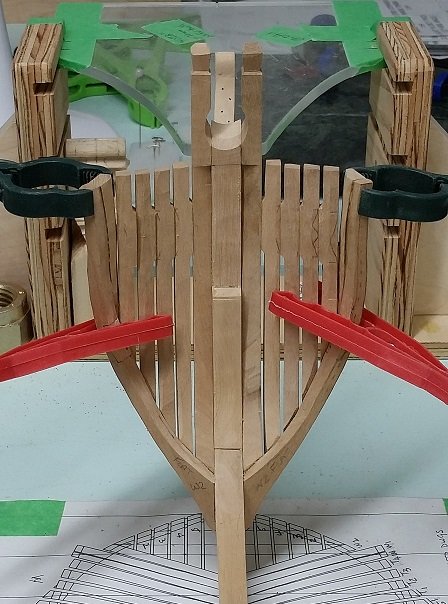
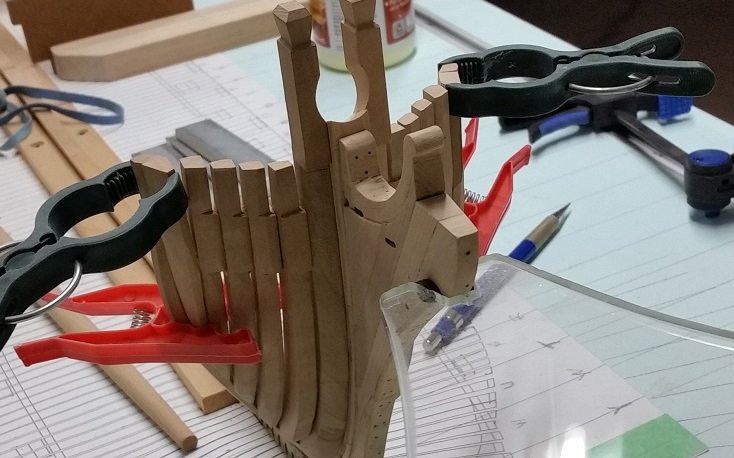
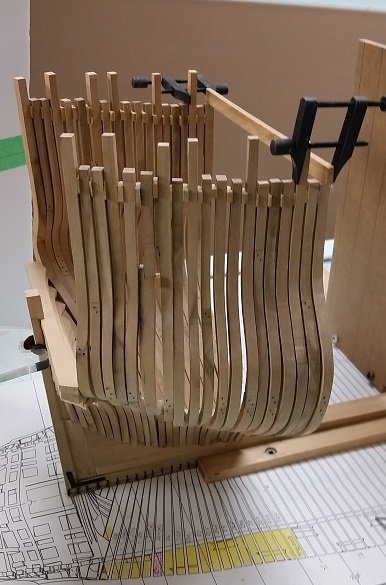

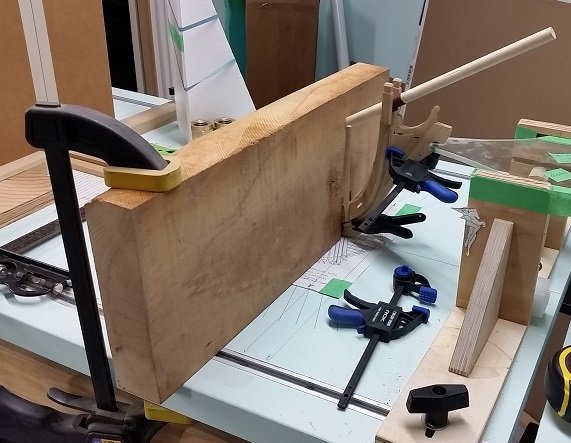
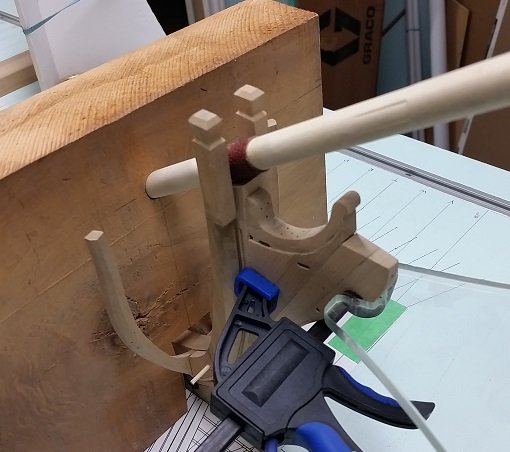
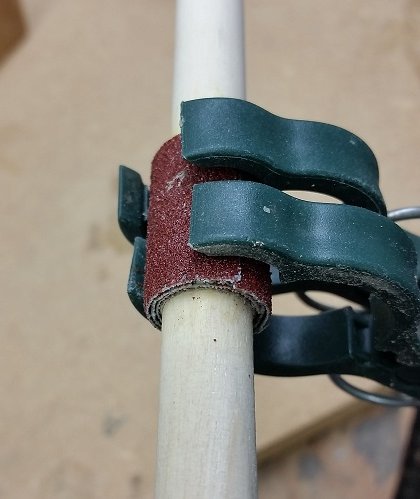
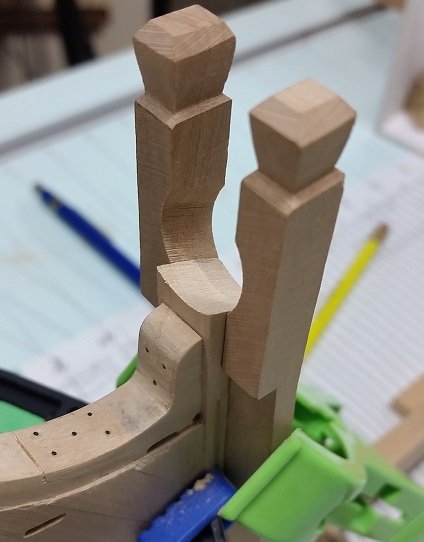
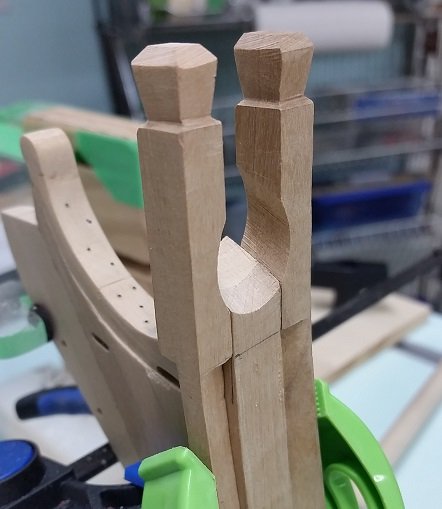

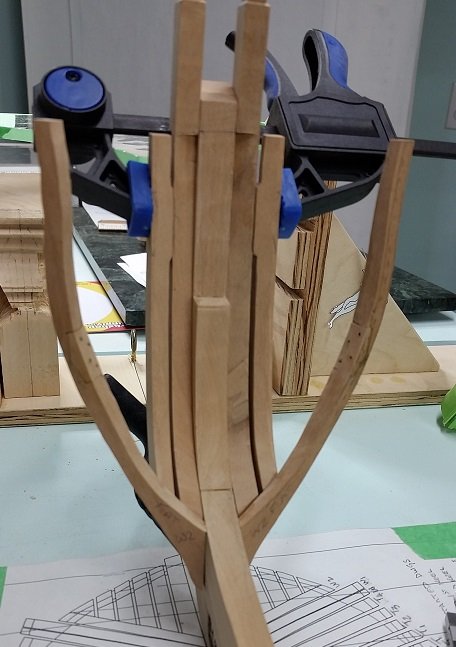
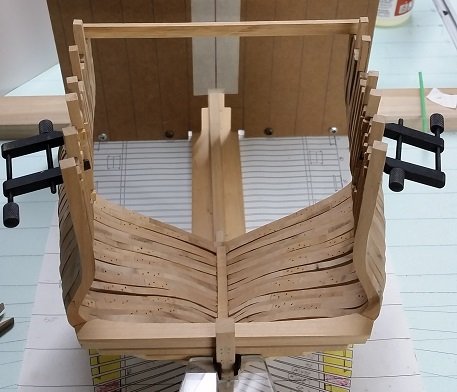

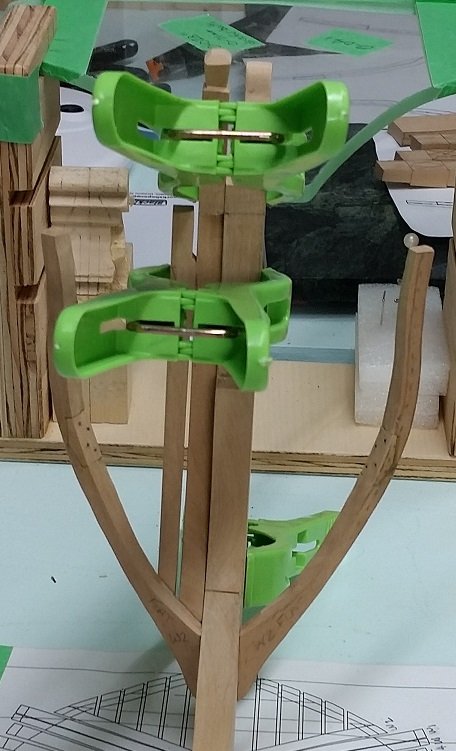
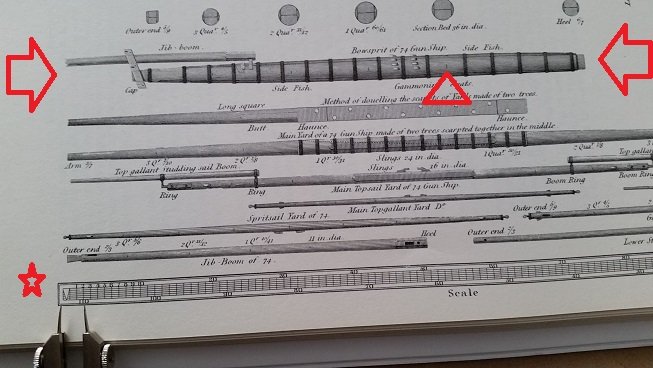
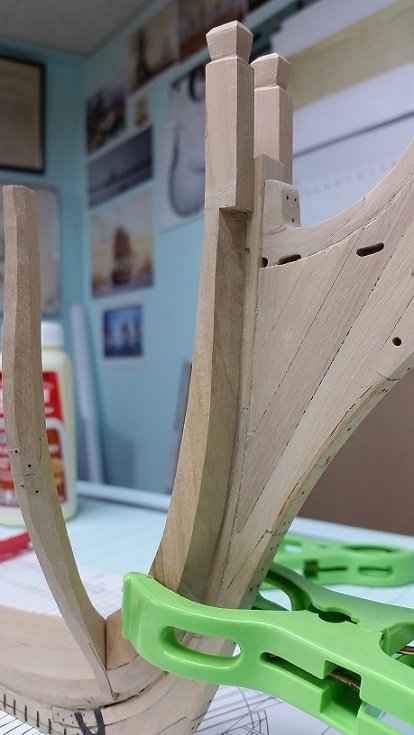
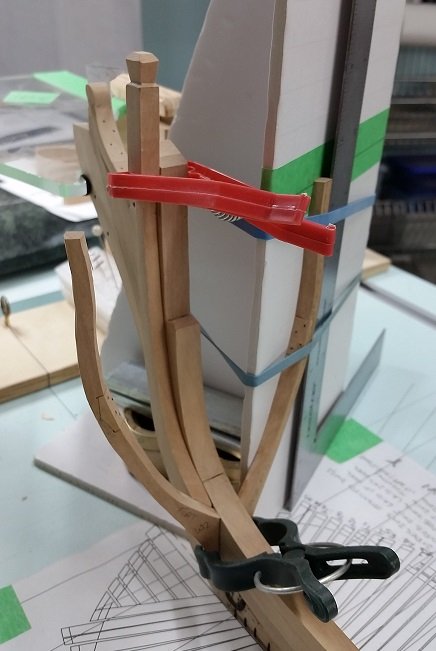
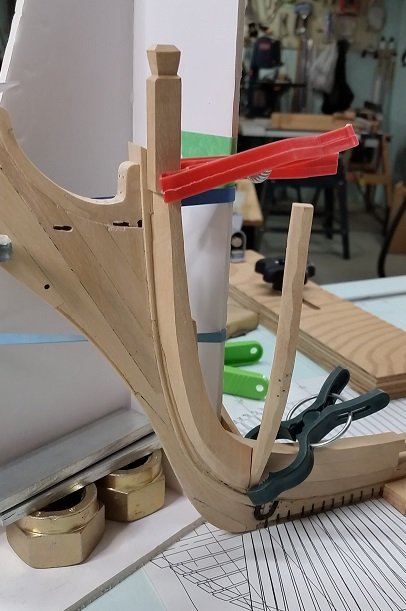
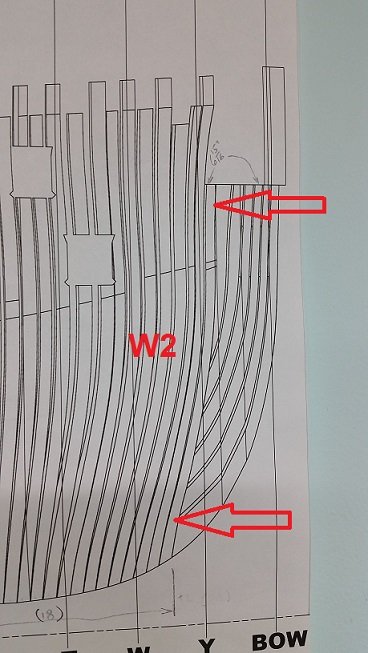
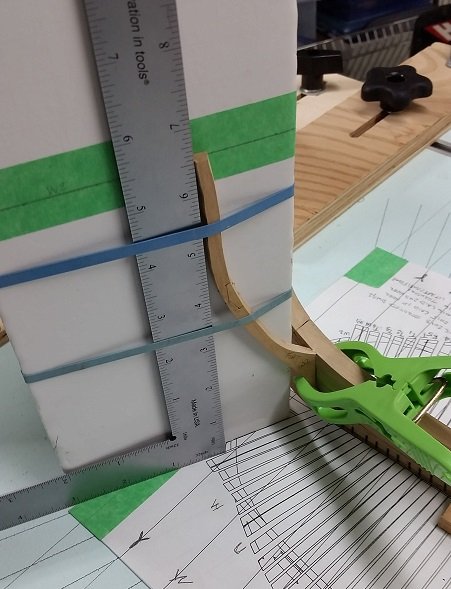
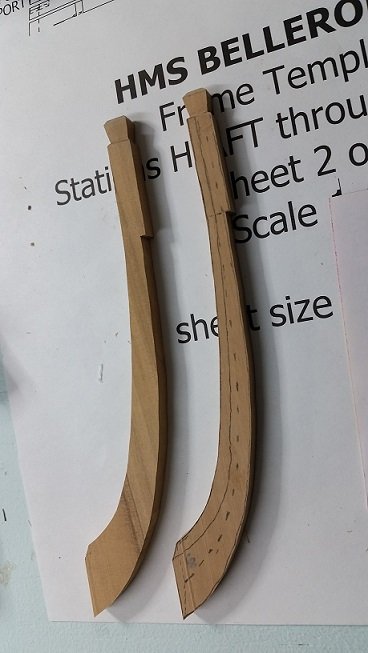
HMS Bellerophon 1786 by AON – scale 1:64 – 74-gun 3rd Rate Man of War - Arrogant-Class
in - Build logs for subjects built 1751 - 1800
Posted · Edited by AON
Also, I made a quick bowsprit at about 37+ inches diameter (Ree's says it is 36" diameter) to see how it would look.
I am not happy with the gap and so will make it a little larger.
No one will be taking a caliper to it!
Then I researched the finished shape of the cap end of the bowsprit to accept the BEES and made notes.
I'll be making a good bowsprit soon enough to have a change of pace... after all they say a change is as good as a raise!